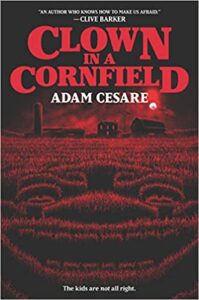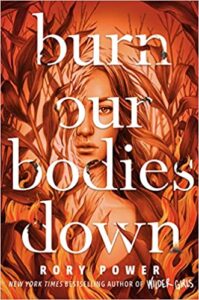 ( Bookshop.org | Amazon.com )
( Bookshop.org | Amazon.com )
Clown in a Cornfield by Adam Cesare
HarperTeen, 2020
ISBN-13 : 978-0062854599
Available: Hardcover, Kindle edition, audiobook
Clown in a Cornfield has the cover art, title, and pacing I’d expect from a pulp paperback from the 1970s-1980s, but a very contemporary feel. It takes place in a small, rural town in Missouri. Quinn Maybrook has just moved from Philadelphia to Kettle Springs, where her father has taken over the town doctor’s practice to give both of them a fresh start after her mother died by drug overdose. A year prior to the events of the book, Cole Hill and his friends livestreamed a prank for their YouTube channel that led to the accidental death of Cole’s younger sister, and shortly before the story begins, Cole attempted to burn down an abandoned factory owned by his father’s company, Baypen. Baypen’s mascot is a clown, Frendo, and it might as well be Kettle Springs’ mascot, as well.
Quinn’s first day at school gets a rocky start when she is caught in the crossfire between Cole and his friends and the science teacher as he angrily ejects them from his classroom, but she soon finds herself included in the group. Quinn discovers that almost everything they do is to get an on-camera reaction. A dangerous prank at the town’s Founder’s Day parade causes a lot of anger in the community, especially from the sheriff, who holds a lot of power and is a very convincing man.
The teens have planned a party in a barn in the middle of a cornfield on the farm of a family who has left on vacation, and despite the damage, a huge crowd arrives to drink and dance. That’s when Frendo, the clown, shows up, and events quickly escalate into a large-scale, fast-paced, violent, and bloody massacre.
Small, rural towns in mid-America tend to be very conservative, very white, and attached to traditional values. They are mostly financially depressed, mainly because nearby manufacturing has failed and family farming isn’t very profitable. Gun ownership, especially for hunting, is common. And communities are usually small enough that their identities center on high school sports, including the mascots. I’ve worked in a really small, rural town, and every day when I got off the highway exit I drove past miles and miles of corn. Cesare really captures the character of these communities, and while some characters are relatively stock, such as the sheriff, others are well-fleshed out. I especially was impressed with the portrayal of Rust, who could easily have been a cariacature of a gun-happy redneck but instead was a nuanced, thoughtful, and resourceful character. There’s also positive representation of gay characters, and an interesting Asian “mean girl”.
My daughter didn’t feel that the motivation for the massacre was believable, but having watched the events of the past week play out, I can now fully believe that clowns could turn in a violent and deadly way on people they feel alienated from if they believe there is a threat to their way of life. Clown in a Cornfield moves along quickly and may appeal to reluctant readers. Slasher fans and teens looking for a terrifying, gory story will find it here. Highly recommended for grades 9+.
Contains: extreme violence, gore, murder, body horror






Follow Us!